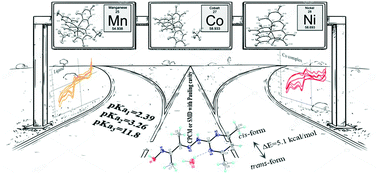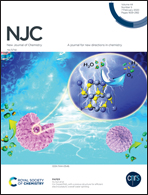Theoretical and experimental study of the coordination ability of 4,6-dimethylpyrimidinylhydrazone diacetylmonooxime towards Ni(ii), Mn(ii), Fe(iii) and Co(iii) ions†
Abstract
The ligand system diacethylmonooxime 4,6-dimethylpyrimidylhydrazone and its Ni(II), Mn(II), Fe(III) and Co(III) complexes with composition [Ni(H2L)2]Cl2·1.17H2O, [Mn(H2L)2](ClO4)2·0.75H2O, [Fe(H2L)2]·3Cl·H2O and [Co(HL)2]·ClO4 have been synthesized. The structure of both the ligand and complexes has been established through IR and 1H NMR spectroscopy, magnetic measurements and X-ray analysis. The acid–base properties of the hetarylhydrazone were studied with potentiometric and spectrophotometric methods. The protolytic equilibrium constants and energies of possible ligand tautomeric forms have been obtained with these data and from quantum-chemical calculations. These calculated pKa values are compared to the computational data. The structures of the hetarylhydrazone and its Ni(II), Mn(II) and Co(III) complexes have been also determined by X-ray analysis. It was shown that the high-spin Ni(II), Mn(II), and Fe(III) complexes possess a distorted-octahedral structure of the coordination unit. The low-spin Co3+ complex has been synthesized by the reaction between Co(ClO4)2 and the hetarylhydrazone, the ligand being reacted in the monodeprotonated pyrimidine tautomeric form. This diacethylmonooxime 4,6-dimethylpyrimidylhydrazone ligand shows potential in stabilizing different metal complexes with interesting reactivity, magnetic and electrochemical properties.



 Please wait while we load your content...
Please wait while we load your content...